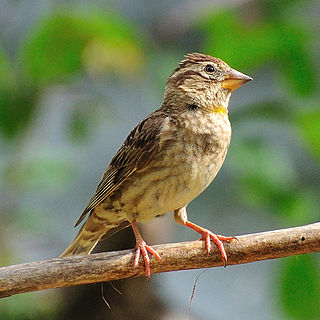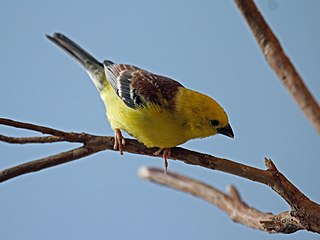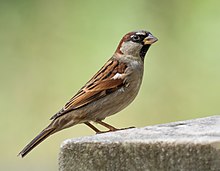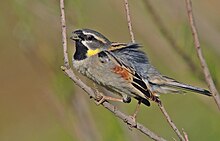
Estrildidae, or estrildid finches, is a family of small seed-eating passerine birds of the Old World tropics and Australasia. They comprise species commonly known as munias, mannikins, firefinches, parrotfinches and waxbills. Despite the word "finch" being included in the common names of some species, they are not closely related to birds with this name in other families, such as the Fringillidae, Emberizidae or Passerellidae.

Ploceidae is a family of small passerine birds, many of which are called weavers, weaverbirds, weaver finches, or bishops. These names come from the nests of intricately woven vegetation created by birds in this family. In most recent classifications, the Ploceidae are a clade that excludes some birds that have historically been placed in the family, such as some of the sparrows, but which includes the monotypic subfamily Amblyospizinae. The family is believed to have originated in the mid-Miocene. All birds of the Ploceidae are native to the Old World, most in Africa south of the Sahara, though a few live in tropical areas of Asia. A few species have been introduced outside their native range.

The rock sparrow or rock petronia is a small passerine bird in the sparrow family Passeridae. It is the only member of the genus Petronia. It breeds on barren rocky hills from the Iberian peninsula and western north Africa across southern Europe and through the Palearctic Siberia and north and central China. It is largely resident in the west of its range, but Asian birds migrate to more southerly areas, or move down the mountains.

The Dead Sea sparrow is a species of bird in the Old World sparrow family Passeridae, with one subspecies breeding in parts of the Middle East and another in western Afghanistan and eastern Iran. The eastern subspecies P. m. yatii is sometimes considered a separate species known as Yate's sparrow.

The Sudan golden sparrow is a small species of bird in the sparrow family found in sub-Saharan Africa. It is a famous cage bird, and in aviculture, it is known as the golden song sparrow. The Arabian golden sparrow and this species are sometimes considered one species, as the "golden sparrow".

The Iago sparrow, also known as the Cape Verde or rufous-backed sparrow, is a passerine bird of the sparrow family Passeridae. It is endemic to the Cape Verde archipelago, in the eastern Atlantic Ocean near western Africa. Females and young birds have brown plumage with black marks above, and a dull grey underside, and are distinguished from other species of sparrow by their large, distinct supercilium. Males have a brighter underside and bold black and chestnut stripes on their head. At 12.5–13 centimetres (4.9–5.1 in) long, it is a smaller sparrow. This bird's vocalisations are mostly variations on its chirp, which differ somewhat between males and females.

Passer is a genus of sparrows, also known as the true sparrows. The genus contains 28 species and includes the house sparrow and the Eurasian tree sparrow, two of the most common birds in the world. They are small birds with thick bills for eating seeds, and are mostly coloured grey or brown. Native to the Old World, some species have been introduced throughout the world.

Montifringilla is a genus of passerine birds in the sparrow family Passeridae. It is one of three genera containing the snowfinches. As the English and scientific names suggest, these are high-altitude species, found in the mountain ranges of southern Eurasia, from the Pyrenees east to the Himalayas, Tibet and western China.
Snowfinches are a natural group of small passerine birds in the sparrow family Passeridae. At one time all eight species were placed in the genus Montifringilla but they are now divided into three genera:

The chestnut sparrow is a species of passerine bird in the sparrow family Passeridae. It is the smallest member of the sparrow family, at about 11 cm (4.3 in) long. The breeding male has deep chestnut plumage and the female and juvenile are coloured a duller grey with some chestnut markings. Like its closest relatives in the genus Passer, the Arabian golden sparrow and the Sudan golden sparrow, it is gregarious and found in arid areas. Ranging through the east of Africa from Darfur in Sudan to Tanzania, it is found in dry savanna, papyrus swamps, and near human habitation. Adults and juveniles both feed mostly on grass seeds, and fly in flocks, often with other species of birds, to find food. It nests in trees, building its own domed nests, and also usurping the more elaborate nests of weavers.

The Cape sparrow, or mossie, is a bird of the sparrow family Passeridae found in southern Africa. A medium-sized sparrow at 14–16 centimetres (5.5–6.3 in), it has distinctive plumage, including large pale head stripes in both sexes. Its plumage is mostly grey, brown, and chestnut, and the male has some bold black and white markings on its head and neck. The species inhabits semi-arid savannah, cultivated areas, and towns, and ranges from the central coast of Angola to eastern South Africa and Eswatini. Three subspecies are distinguished in different parts of its range.

The russet sparrow, also called the cinnamon or cinnamon tree sparrow, is a passerine bird of the sparrow family Passeridae. A chunky little seed-eating bird with a thick bill, it has a body length of 14 to 15 cm (5.5–5.9 in). Its plumage is mainly warm rufous above and grey below. It exhibits sexual dimorphism, with the plumage of both sexes patterned similarly to that of the corresponding sex of house sparrow. Its vocalisations are sweet and musical chirps, which when strung together form a song.

The Sind sparrow is a passerine bird of the sparrow family, Passeridae, found around the Indus valley region in South Asia specially Sindh. It is also known as the jungle, Sind jungle, or rufous-backed sparrow. Very similar to the related house sparrow, it is smaller and has distinguishing plumage features. As in the house sparrow, the male has brighter plumage than female and young birds, including black markings and a grey crown. Distinctively, the male has a chestnut stripe running down its head behind the eye, and the female has a darker head than other sparrow species. Its main vocalisations are soft chirping calls that are extended into longer songs with other sounds interspersed by breeding males. Historically, this species was thought to be very closely related to the house sparrow, but its closest evolutionary affinities may lie elsewhere. The species was discovered around 1840, but went undetected for several decades afterwards.

The Afghan snowfinch or the Afghan ground-sparrow, bar-tailed snowfinch, Meinertzhagen's snowfinch, or Theresa's snowfinch, is a passerine bird of the sparrow family Passeridae, endemic to the northern parts of the Hindu Kush mountains in Afghanistan. There are no major threats to the species despite its restricted range, so it is assessed as least concern on the IUCN Red List. This species is mostly a seed-eater, supplementing its diet with some insects. It builds its nest in the burrows or hollows of ground-dwelling rodents, lined with hair or feathers.

The painted finch is a common species of estrildid finch found in Australia. The painted finch acquired its name due to the red and white spotted and mottled underparts of both males and females. The binomial comes from emblema meaning 'mosaic or inlaid work'; and pictum derives from the Latin word pictus, meaning 'painted'. Other names include Emblema finch, mountain finch, painted firetail and Emblema. The painted finch is a popular bird to be kept in captivity and in backyard aviaries.

New World sparrows are a group of mainly New World passerine birds, forming the family Passerellidae. They are seed-eating birds with conical bills, brown or gray in color, and many species have distinctive head patterns.

The orange weaver is a species of bird in the weaver family, Ploceidae. It is sparsely distributed across African tropical rainforest.

The grey-capped social weaver is a sparrow-like liver-colored bird, with a pale grey crown, a dark grey bill, a whitish eye-ring, horn-colored legs, with some black in the wing and a light terminal band in the tail, that builds roofed nests made of straws, breeds in colonies in thorny Acacia trees, and feeds in groups gathering grass seeds and insects. Male and female have near identical plumage. DNA-analysis confirms it is part of the weaver family. It is found in Ethiopia, Kenya, Somalia, South Sudan, Sudan, Tanzania, and Uganda.

The black-capped social weaver is a sparrow-like species of bird that has been assigned to the weaverbird family. It was originally described by Fisher and Reichenow, and later re-classified by the latter to the genus Pseudonigrita. Adults have a large black cap, ivory-colored bill, red eyes, brown back and wings, blackish-brown tail, white throat and underparts with a black midline, and dark horn-colored legs. It breeds in colonies and roofed nests with an entrance at the bottom in thorny trees such as acacias are constructed by the male from grass stems. It is found in parts of Ethiopia, Kenya, Somalia, and Tanzania. It is sometimes kept and bred in captivity.

Gymnoris is a genus of passerine birds in the sparrow family Passeridae. Three species are found in Africa while the yellow-throated sparrow ranges from Turkey to India.




































